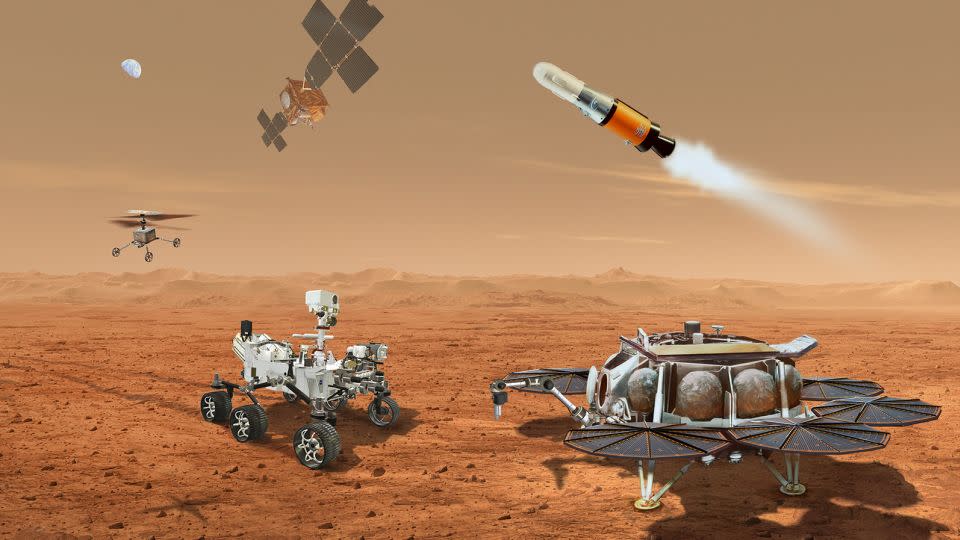Sign up for CNN’s Wonder Theory science newsletter. Explore the universe with news about fascinating discoveries, scientific advancements and more.
NASA is looking for innovative methods that could help retrieve samples collected by the Perseverance rover on Mars in the future.
The rover, which landed on Mars in February 2021, is collecting samples from Jezero Crater, where an ancient lake and river delta once existed on the red planet. Scientists believe the samples could help them better understand whether life exists on Mars.
The original design of the Mars Sample Return program, a partnership between NASA and the European Space Agency, was complex. The architecture included multiple missions launching from Earth to Mars to collect samples and then performing the first rocket launch from the surface of another planet to return samples to Earth.

However, there were concerns that the program was too cumbersome due to its complexity, expense and delayed return date, which was originally expected to occur in 2031, but was postponed following evaluations by an independent review board. Budget cuts affecting NASA also put the program at risk.
NASA Administrator Bill Nelson and Nicky Fox, deputy administrator for NASA’s Science Mission Directorate, shared the federal agency’s response to the independent review board on Monday.
Nelson said reviews of the program suggest the Mars Sample return should cost no more than $5 billion to $7 billion. But he said NASA has had to deal with the constraints of reduced spending due to budget cuts for fiscal years 2024 and 2025, causing the agency to take a $2.5 billion hit.
“The Mars Sample Return will be one of the most complex missions NASA has ever undertaken. Ultimately, an $11 billion budget is too expensive and a 2040 return date is too far away,” Nelson said. “Safely landing and collecting samples, launching a rocket with samples from another planet – something that has never been done before – and safely transporting the samples 33 million miles (53 million kilometers) back to Earth is no small task. And cost-effective “We also need to look outside the box to find a way to return samples in a reasonable time frame.”
Waiting until 2040 to send samples back to Earth is unacceptable because the 2040s are “the decade when we’re going to land astronauts on Mars,” Nelson said and reiterated at a news conference Monday.
Less budget and rising costs impact Mars Sample Return
Nelson said an $11 billion price tag for the program would cause NASA to cannibalize other science programs and missions.
These missions include the NEO, or Near-Earth Object Searcher, to discover asteroids that may pose a risk to Earth; Dragonfly, which will investigate the potential habitability of Saturn’s moon Titan; Missions like DAVINCI and VERITAS to uncover the secrets of Venus. (The Venus mission names stand for Deep Atmosphere Venus Survey of Noble Gases, Chemistry and Imaging Plus, and Venus Emissivity, Radio Science, InSAR, Topography, and Spectroscopy.)
While Nelson is hopeful that the fiscal year 2026 budget won’t be tight enough to open up more science funding for NASA, it doesn’t solve the immediate problem of how to handle moving forward with Mars Sample Return.
The space agency is calling for help.
Innovation and reliable technology
According to Fox, agency officials will soon announce requests to NASA centers and industry to develop a new plan that combines innovation with lessons learned from proven technology. He said NASA is targeting the 2030s for a sample return mission with less complexity, cost and risk.
Nelson said it was a quick turnaround for proposals and that the agency expects to hear answers about how best to return samples from Mars by the fall.
Fox said the main condition of the proposals was the return of 30 scientifically selected samples that Perseverance had taken from various locations.
“Mars is extremely important to us,” Fox said. “It’s one of the only places where life can exist. However, we understand that we may need to narrow down the sample count to get things done faster.”
Fox said a new architecture request for Mars Sample Return would include a series of samples requested to return to Earth.
“We operate under the assumption that returning samples is an important national goal,” Nelson said.
It reinforced the idea that NASA did not want to end the program because it was seen as so critical, especially at a time when the agency was planning to land astronauts on the red planet going forward.
Meanwhile, Fox said current decisions will not affect the scientific plan for Perseverance’s journey to Mars and that the rover continues to collect samples while investigating the crater rim.
looking to the future
NASA’s Jet Propulsion Laboratory in Pasadena, California, manages the Perseverance rover mission and other exploration efforts on Mars.
Existing efforts for the turnaround program were underway at JPL when layoffs occurred in February to meet the requirements of budget cuts. The new architecture ultimately developed for the sample return mission will determine the scope of JPL’s management oversight, Nelson said.
The European Space Agency also played a major role in the development of the program, and Fox confirmed that the agency is still involved in discussions about the program’s future.
Fox said that for fiscal year 2025, NASA has proposed a budget request of $200 million while evaluating alternative architectures; This will also allow other planetary science to continue at JPL and other NASA centers.
“To organize a mission of this level of complexity, we draw on decades of lessons on how to execute a large mission, including input from independent reviews,” Fox said. “Our next steps will position us to advance this transformational mission and deliver revolutionary science from Mars, providing critical new information about the origins and evolution of Mars, our solar system, and life on Earth.”
For more CNN news and newsletters, create an account at CNN.com